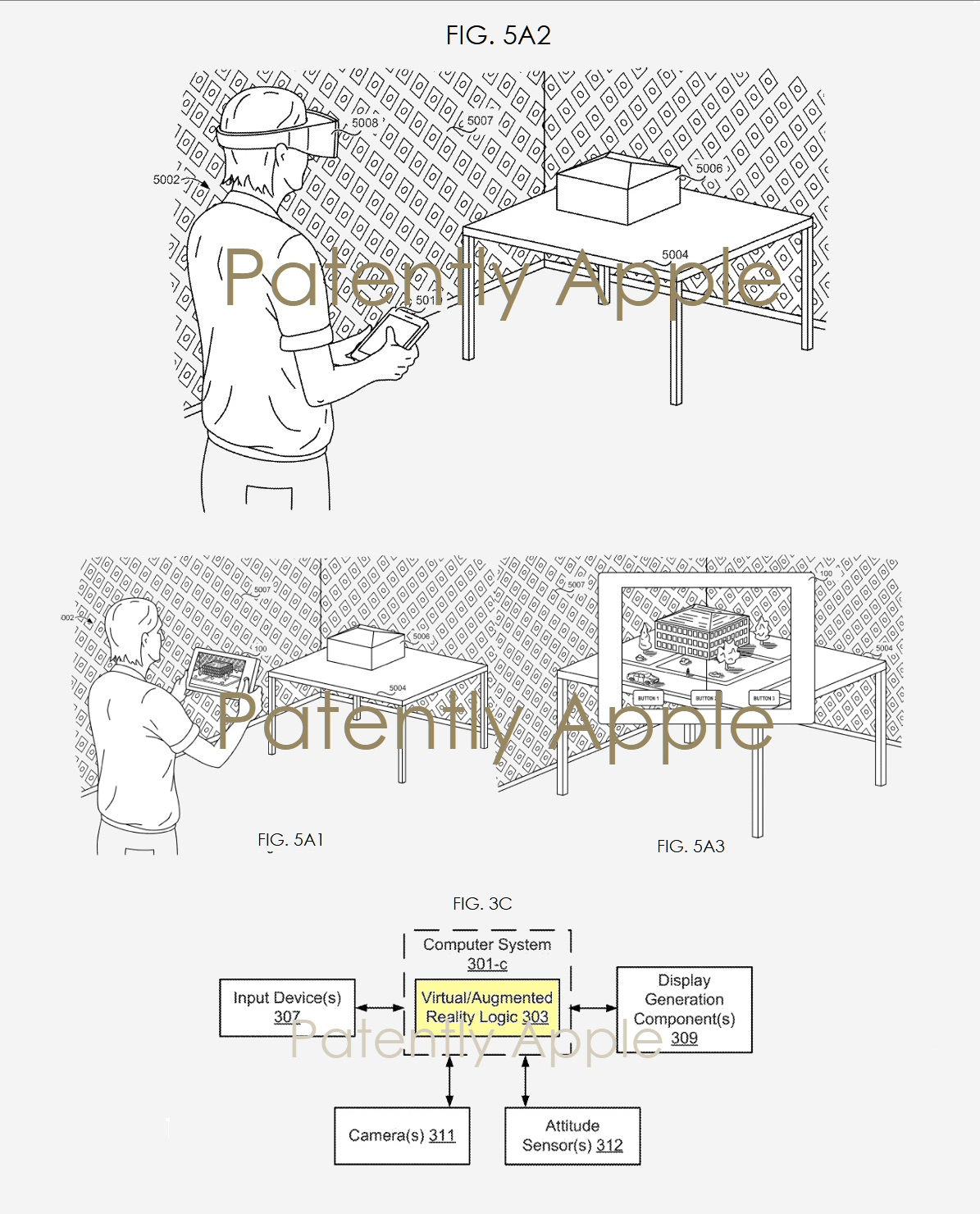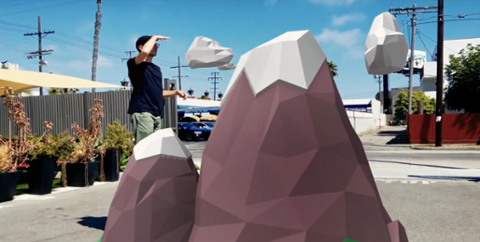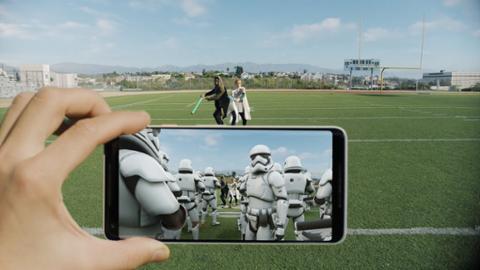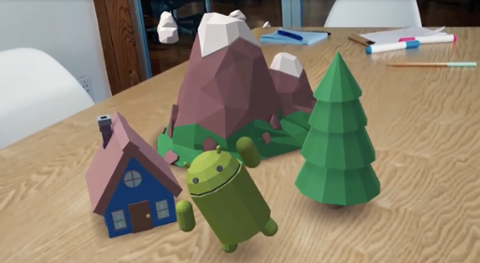 This is not what we want from augmented reality. In fact, this will earn AR a ‘hard pass’ from many consumers. We’re looking for discreet headwear that can overlay digital items onto our real environments; a phone or tablet might serve as a sort of ‘mother brain’ for the eyewear, feeding it things like GPS data, but we shouldn't have to juggle a handheld device while hearing a headset. This all seems a concession to the realities of hardware, and might hint that the AR future we’ve all been expecting is nowhere close to fruition. If ‘rOS’ is really landing in 2020, we’re about two years away from its official launch (which would almost definitely be at WWDC, which is typically in June). If Apple is leading the way on mobile AR, this patent shows their advanced work is still lacking. But we’ve been seeing AR’s promise declining for a while. Magic Leap was more hype than hope, and still hasn’t done anything meaningful. HoloLens 2, while expensive, is the best stab we’ve seen at a true heads-up display that accepts gestures as input – and Microsoft is outright claiming it’s not a consumer device. More discreet AR headsets look the part, but do little more than flash icons in your field of view so you know to look at your phone (Thanks?). If augmented reality is really evolving this slowly, developers should consider their potential use-cases for the technology. We’re already seeing AR used for workplace collaboration, which opens up more doors for the technology, but is it really useful for everyone? How many users will want AR spreadsheets or pop-up text messages that do little more than prompt you to turn to a more traditional device for interaction? We’re guessing the market for AR for the foreseeable future will remain relatively narrow (outside of some games and productivity applications), and that’s just plain disappointing.
This is not what we want from augmented reality. In fact, this will earn AR a ‘hard pass’ from many consumers. We’re looking for discreet headwear that can overlay digital items onto our real environments; a phone or tablet might serve as a sort of ‘mother brain’ for the eyewear, feeding it things like GPS data, but we shouldn't have to juggle a handheld device while hearing a headset. This all seems a concession to the realities of hardware, and might hint that the AR future we’ve all been expecting is nowhere close to fruition. If ‘rOS’ is really landing in 2020, we’re about two years away from its official launch (which would almost definitely be at WWDC, which is typically in June). If Apple is leading the way on mobile AR, this patent shows their advanced work is still lacking. But we’ve been seeing AR’s promise declining for a while. Magic Leap was more hype than hope, and still hasn’t done anything meaningful. HoloLens 2, while expensive, is the best stab we’ve seen at a true heads-up display that accepts gestures as input – and Microsoft is outright claiming it’s not a consumer device. More discreet AR headsets look the part, but do little more than flash icons in your field of view so you know to look at your phone (Thanks?). If augmented reality is really evolving this slowly, developers should consider their potential use-cases for the technology. We’re already seeing AR used for workplace collaboration, which opens up more doors for the technology, but is it really useful for everyone? How many users will want AR spreadsheets or pop-up text messages that do little more than prompt you to turn to a more traditional device for interaction? We’re guessing the market for AR for the foreseeable future will remain relatively narrow (outside of some games and productivity applications), and that’s just plain disappointing. The Augmented Reality Future We Want May Never Arrive
Augmented reality (AR) is kind of the chimera of tech. Big companies such as Apple and Google have software platforms dedicated to AR, but we’re still waiting on discreet headwear to make the technology more viable for day-to-day use. A new patent suggests we’re getting there, but not at the pace we may prefer. The rumored go-live date for Apple’s heads-up display is somewhere around 2020 or 2021, replete with a bespoke platform called ‘rOS' (the ‘r’ is likely for ‘reality,’ if that’s the platform’s final name). Via Patently Apple, a website that keeps a close eye on the patents Apple publishes via the U.S. Patent & Trademark Office, we find the company's recently published patent for such a display. If this patent is any indication, the ability to leave our phone in a pocket or bag and interact with an augmented-reality environment without a touchscreen is not on the immediate horizon. Indeed, the patent shows a headset being used in conjunction with a phone or tablet to interact with AR objects. (The patent also suggests a user could control it via a computer such as a MacBook.)  This is not what we want from augmented reality. In fact, this will earn AR a ‘hard pass’ from many consumers. We’re looking for discreet headwear that can overlay digital items onto our real environments; a phone or tablet might serve as a sort of ‘mother brain’ for the eyewear, feeding it things like GPS data, but we shouldn't have to juggle a handheld device while hearing a headset. This all seems a concession to the realities of hardware, and might hint that the AR future we’ve all been expecting is nowhere close to fruition. If ‘rOS’ is really landing in 2020, we’re about two years away from its official launch (which would almost definitely be at WWDC, which is typically in June). If Apple is leading the way on mobile AR, this patent shows their advanced work is still lacking. But we’ve been seeing AR’s promise declining for a while. Magic Leap was more hype than hope, and still hasn’t done anything meaningful. HoloLens 2, while expensive, is the best stab we’ve seen at a true heads-up display that accepts gestures as input – and Microsoft is outright claiming it’s not a consumer device. More discreet AR headsets look the part, but do little more than flash icons in your field of view so you know to look at your phone (Thanks?). If augmented reality is really evolving this slowly, developers should consider their potential use-cases for the technology. We’re already seeing AR used for workplace collaboration, which opens up more doors for the technology, but is it really useful for everyone? How many users will want AR spreadsheets or pop-up text messages that do little more than prompt you to turn to a more traditional device for interaction? We’re guessing the market for AR for the foreseeable future will remain relatively narrow (outside of some games and productivity applications), and that’s just plain disappointing.
This is not what we want from augmented reality. In fact, this will earn AR a ‘hard pass’ from many consumers. We’re looking for discreet headwear that can overlay digital items onto our real environments; a phone or tablet might serve as a sort of ‘mother brain’ for the eyewear, feeding it things like GPS data, but we shouldn't have to juggle a handheld device while hearing a headset. This all seems a concession to the realities of hardware, and might hint that the AR future we’ve all been expecting is nowhere close to fruition. If ‘rOS’ is really landing in 2020, we’re about two years away from its official launch (which would almost definitely be at WWDC, which is typically in June). If Apple is leading the way on mobile AR, this patent shows their advanced work is still lacking. But we’ve been seeing AR’s promise declining for a while. Magic Leap was more hype than hope, and still hasn’t done anything meaningful. HoloLens 2, while expensive, is the best stab we’ve seen at a true heads-up display that accepts gestures as input – and Microsoft is outright claiming it’s not a consumer device. More discreet AR headsets look the part, but do little more than flash icons in your field of view so you know to look at your phone (Thanks?). If augmented reality is really evolving this slowly, developers should consider their potential use-cases for the technology. We’re already seeing AR used for workplace collaboration, which opens up more doors for the technology, but is it really useful for everyone? How many users will want AR spreadsheets or pop-up text messages that do little more than prompt you to turn to a more traditional device for interaction? We’re guessing the market for AR for the foreseeable future will remain relatively narrow (outside of some games and productivity applications), and that’s just plain disappointing.
 This is not what we want from augmented reality. In fact, this will earn AR a ‘hard pass’ from many consumers. We’re looking for discreet headwear that can overlay digital items onto our real environments; a phone or tablet might serve as a sort of ‘mother brain’ for the eyewear, feeding it things like GPS data, but we shouldn't have to juggle a handheld device while hearing a headset. This all seems a concession to the realities of hardware, and might hint that the AR future we’ve all been expecting is nowhere close to fruition. If ‘rOS’ is really landing in 2020, we’re about two years away from its official launch (which would almost definitely be at WWDC, which is typically in June). If Apple is leading the way on mobile AR, this patent shows their advanced work is still lacking. But we’ve been seeing AR’s promise declining for a while. Magic Leap was more hype than hope, and still hasn’t done anything meaningful. HoloLens 2, while expensive, is the best stab we’ve seen at a true heads-up display that accepts gestures as input – and Microsoft is outright claiming it’s not a consumer device. More discreet AR headsets look the part, but do little more than flash icons in your field of view so you know to look at your phone (Thanks?). If augmented reality is really evolving this slowly, developers should consider their potential use-cases for the technology. We’re already seeing AR used for workplace collaboration, which opens up more doors for the technology, but is it really useful for everyone? How many users will want AR spreadsheets or pop-up text messages that do little more than prompt you to turn to a more traditional device for interaction? We’re guessing the market for AR for the foreseeable future will remain relatively narrow (outside of some games and productivity applications), and that’s just plain disappointing.
This is not what we want from augmented reality. In fact, this will earn AR a ‘hard pass’ from many consumers. We’re looking for discreet headwear that can overlay digital items onto our real environments; a phone or tablet might serve as a sort of ‘mother brain’ for the eyewear, feeding it things like GPS data, but we shouldn't have to juggle a handheld device while hearing a headset. This all seems a concession to the realities of hardware, and might hint that the AR future we’ve all been expecting is nowhere close to fruition. If ‘rOS’ is really landing in 2020, we’re about two years away from its official launch (which would almost definitely be at WWDC, which is typically in June). If Apple is leading the way on mobile AR, this patent shows their advanced work is still lacking. But we’ve been seeing AR’s promise declining for a while. Magic Leap was more hype than hope, and still hasn’t done anything meaningful. HoloLens 2, while expensive, is the best stab we’ve seen at a true heads-up display that accepts gestures as input – and Microsoft is outright claiming it’s not a consumer device. More discreet AR headsets look the part, but do little more than flash icons in your field of view so you know to look at your phone (Thanks?). If augmented reality is really evolving this slowly, developers should consider their potential use-cases for the technology. We’re already seeing AR used for workplace collaboration, which opens up more doors for the technology, but is it really useful for everyone? How many users will want AR spreadsheets or pop-up text messages that do little more than prompt you to turn to a more traditional device for interaction? We’re guessing the market for AR for the foreseeable future will remain relatively narrow (outside of some games and productivity applications), and that’s just plain disappointing. 


